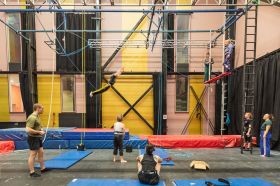Sydney Film Festival has closed but more than 60 ethnic or specialist film festivals are competing to fill the gap in your diary.
Sydney is remarkable for the many national, ethnic, religious, transnational, short, community and specialist film festivals that are now held every year, the number and range of which have exploded over the past 10 years. More than 40 ethnic and 20 specialist film festivals take place every year; together with Sydney Film Festival they provide an annual calendar bulging with filmgoing activity. Seven new festivals started in 2012: the Lebanese, Persian, Polish, Argentine, and Macedonian events, and even the Cat Video Film Festival. Together with the emergence of the Blackfella Films component now part of SFF, does this raise a question about the sustainability of such film-festival growth? And does the rate of proliferation of ethnic and specialist film festivals, together with the continuing growth of SFF, raise issues of event saturation – even bringing into question the future of the film festival format?
In fact, just what is the future relationship between major city festivals and the smaller national festivals? This growth in the past 20 years of ethnic and specialist film festivals has taken place at the same time as specialist and arthouse cinemas have all but disappeared from the cultural landscape. As former Sydney Film Festival director and critic Lynden Barber has jokingly written, “Feeling bored? Open a film festival. Everyone else is … It sometimes appears that not only every major capital city, but every café at the end of every street of every godforsaken one-horse town has a film festival – or soon will have… (Does a three-day event screening material off DVD count?)” With some of these festivals playing in Sydney over three weeks as part of a large national tour, with others taking place over a weekend in modest non-traditional cinematic venues, the future of cultural and presentational diversity is already here. These festivals now make up the broad tapestry of Sydney’s film culture, maintaining diasporic cultures while reaching out to the mainstream and destroying ingrained clichés. Most of the SFF program features cinema from around the world, often competing with, intersecting and, invariably, developing the national cinema festivals. While it is unlikely that this will change, will some of the ethnic and specialist film festivals disappear in this sea of proliferation? That is the assumption of the abundance/saturation logic which asserts that at some point in the near future there will be a tipping point away from unsustainable growth and that the eventual decline could become catastrophic to the film-festival format. However, despite the easy access to informal viewing networks (piracy), to SBS and World Movies, and to the ever-increasing range and diversity of movies on DVD and download, audiences have continued to grow for the national festivals as they mix balanced curatorial programs with distinct artistic and culinary events that may at times feature kitsch, but always celebrate their national culture, purposefully made accessible to the mainstream.
In the period from 2000 to 2007, when multiculturalism was under threat, the first remarkable growth in diasporic film festivals began to fill any potential void of world-cinema consumption in Sydney’s already busy cultural calendar. Since then only the African film festival has gone into a partial hiatus after a few years of existence, while all the other festivals have continued to grow. Remarkably, there is now competition between some festivals for common territories, with many festivals crossing geographic borders. The newly formed Iranian and Persian festivals would seem to be in direct competition, as are the Nordic and the Window to Europe Festivals; the Arab and Lebanese film festivals are vying ostensibly for the same audience. But there is little real competition, with the specialist and short-film festivals largely supporting one another by building on cinema culture. The main competition, between SFF and the ethnic and specialist film festivals, should be seen more as a dialogue and interaction, which suggests that there will be greater synergies between them, more connections, an expanded dialogue, a sharing of information and calendars so that overlapping may be avoided and audiences primed and activated. In fact, a frequent-festival-flyer card and umbrella organisation is imminent, which will foster greater connections between the disparate festivals, develop audiences and bolster the broader festival form and experience.
One of the remarkable aspects of Sydney’s burgeoning film festivals is that with the increasing fragmentation (due to greater specialisation and national-ethnic particularity) there is a simultaneous pull towards homogenisation. The process of increased diversity of content is occurring at the same time as the diversity of the presentation format is contracting, succumbing to a homogenised professional look and feel of the festival experience. Far more festivals now take place in professional, authorised venues than those that, due to budget or choice, are presented in informal and non-standard cinema venues. Ethnic film festivals in Sydney have generated higher levels of cultural diversity and thereby expanded the mainstream, but they have simultaneously tended towards greater slickness in order to attract a mainstream that has lost its predominate whiteness and is now more fluid, more complex and less in contradiction to the ethnic groups than it was even a decade ago. Most festivals have adopted high levels of similarity in their professionalism, with standardised national touring schedules and seemingly correspondingly formatted websites. This trend suggests a “special cultural policy context in which this is taking shape with such uniformity” (Iordanova 2009).
Film scholar Adrian Martin has explained that the spread of the nationally-themed festivals is often associated with the exhibitor, saying, “Palace has always had a strong connection to (mainly European and ‘old school’) art cinema. Its exhibition venues are known to the public as ‘boutique’ or ‘arthouse’ cinemas.” With the Dendy Cinemas also enthusiastically seeking out festival screenings, and even the mainstream Event Cinemas becoming involved with some of the larger festivals, the future format and presentation of film festivals will no doubt feature even greater rates of standardised ‘professionalism’ and higher uniformity with festivals internationally. If there is a gradual reduction in the range of ‘unusual’ programming choice from the marketing and exhibition venues in order to guarantee more predictable audience responses, speciality festivals are already becoming the zone for more marginal fare, while generalist festivals in the future could focus more on ‘safe’ selections. Smaller and more fringe festivals will increasingly struggle to define a value in presenting different formats, and non-traditional venues will become increasingly marginalised.
Rather than following the overload logic that film-festival saturation will lead to an eventual collapse, it is possible to consider that now and in the future festivals will continue to provide an alternate and dynamic platform for non-mainstream film exhibition. The presence of a film festival in Sydney virtually every week of the year goes a long way towards establishing a robust urban film culture without an authoritative central organisation such as Melbourne’s ACMI, and in turn replaces the gap left with the closure of many of the specialist and arthouse film venues across the city. These festivals, along with their growing and developing audience, will continue to present Sydney with greater diversity while providing a competitive spirit of innovation.
More than just films
The future of such film festivals lies as much in their ability to produce special events that are more than just a cinematic experience, but special and glamorous cultural occasions. There seems to be an ongoing appetite for exceptional events and no saturation crisis can stand in the way of a bubbly opening night. The future of the film festival as a special event relies on replacing the standard screening with a rejuvenated and spectacular promotion of an interactive cinema and cultural experience lubricated by liberal refreshments. Ethnic film festivals do opening-night parties particularly well, combining a carefully selected film with the special events celebrating the culture, dance, music, and live performance, together with exotic culinary and authentic beverages of the ethnic national traditions. Lars Henrik Gass argues that in order for film festivals to endure and avoid becoming obsolete they must “evolve away from simply being a place for screening movies to something entirely different” (2009). This is certainly true of opening nights at all ethnic film festivals. The opening-night parties, the Q&As, the discussions, even the high teas – all of these special occasions provide important marks of distinction and create the memorable aspects of a film festival. There is considerable value in community self-celebration and in how the mainstream is invited to view the community through their imported films and the festival programming and organisation.
Battles are inevitable between the liberals and the cultural conservatives, between those who seek more experimental and edgy fare against those seeking resonances with the films and standards of their youth. According to Marijke de Valck, from the early days, “The festival was presented as an international and glamorous event attended by an elite audience of film professionals and the beau monde.” (2007). This association remains an important part of the festival cache with the opening- and closing-night parties, special events and the atmosphere of exclusivity and elitism that has been amplified in the festival scene and spread across a range of festivals, with each trying to outdo the other. The opening night is an especially crucial social event where the beau monde mix with the ethnic community and there is a cultural requirement to stage an opening-night film that responds directly to (external) cultural imaginings of these communities as well as fulfilling future or at least contemporary experiences of that community (internally). The beau monde seek exoticism and a fulfilment of expectations, whereas the ethnic community demand a combination of external assessment of quality (international awards), internal cultural respect and the repetition of nostalgic standards. The future of such film festivals lies in being able to maintain that fine balance between constituent established (diasporic) audiences and the new and emerging audiences that constitute the mainstream. The careful management of special events is far more important in developing the future of the film festival than the development of new booking apps.
Conclusion
There may be considerable anxiety that an unchecked proliferation of festivals will dilute scarce audiences and lower standards in world cinema; that a greater homogenisation in presentation formats and content, especially of commercially ‘safe’ programs, will lead to an eventual collapse of audiences and supporters. However there is no real evidence of a cinema-saturation logic leading to such a collapse. Instead, it appears that the proliferation of festivals, especially in Sydney with its long absence of a centralised cinema institution, has generated a de facto film culture that is inclusive, broad ranging and expanding, engaging fresh audiences across dispersed interests and geographic locations. The real challenge for the festivals, for government agencies and for sponsors, is to ponder how festivals can ensure their liquidity and longevity while not undermining their branding and content through tawdry commercialisation. In solving this challenge, future festivals will become more interactively involved with audiences and the extra-cinematic experience. They will be more events oriented, more digitally discursive, but also produced to include more ‘live’ avenues for audience engagement in the whole festival experience.
This article was first published by the Sydney Film Festival.





